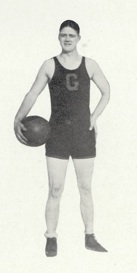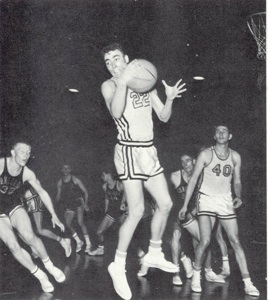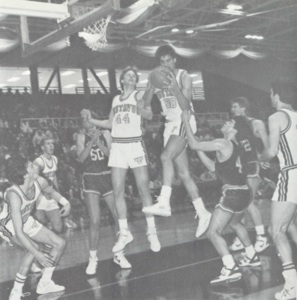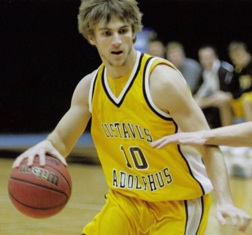Uniforms

The Gustavus men’s basketball program has been around for quite some time. Since the early 1900’s, Gustavus has proudly trotted out its finest athletes to commence war on the hardwood. Over time, many things have changed. The balls have changed to become more consistent and more durable and the backboards have become a rectangle as opposed to a fan shaped one as seen in the earlier days. The style of play has changed drastically from the time when each player’s position was their exact role on the team. The shooting guard was literally the shooting guard. The one thing that has changed most obviously, even to someone who knows little about basketball, are the uniforms. As seen below, the styles and materials of the uniforms have changed dramatically over time.
The uniforms worn by the class of 1913 show what the original basketball uniforms of Gustavus looked like. The very small, matching, cotton t-shirts, the matching black shorts, probably made of a material similar to those of current dress pants, the high black socks and the uncomfortable dress/athletic shoes of the time combine to make this portrait look like one taken at gym class, not one of a collegiate basketball team.
The uniforms of the late twenties shed the warm socks and shirt for a more breathable uniform. The black shorts, albeit slightly shorter than before, are still worn with a dress belt however. Numbers have not yet appeared on the jerseys.
15 years later and the uniforms have changed dramatically. The shorts have become even shorter and the uniforms now include a number for each player. The Gusties have also shed their black jerseys for a new white set (although black jerseys may still remain). Their shoes have been drastically improved but it is also interesting to note that kneepads were worn by the Gusties. The players still have belts to keep their trousers up.
The jerseys worn by the Gusties in the 1962 season are becoming more and more contemporary. The black shoes of the previous photos have been replaced by shiny white Converses. The uniforms have added many solid black stripes to make them more aesthetically appealing. It is interesting to note the Gusties have shed their name on the jerseys and now just have numbers on the front and back. Also, belts have finally been removed.
Gustavus’ 1987 jerseys provide a look back at the old, more conservative ones of the 50’s and 60’s. The striped bands appear to still be in fashion, but one notable difference is the emergence of mid-length white socks. Nike and other brands of shoes can be seen, although the Converses are still very popular. These jerseys also display, for the first time, the Three Crowns that have come to signify Gustavus Adolphus College.
The seventies brought about some interesting styles to the American culture, and the basketball court at Gustavus was no exception. Gone are the plain looking jerseys. In comes a jersey with alternating colors all around on both the shorts and jerseys. High white socks with colored bands also became very popular on the court, as did flowing long hair. This long hair must have made the players very warm, so they decided to keep their shorts very short in order to cool them down a little bit.
The current jerseys of Gustavus’s men’s basketball team provide a very traditional look. The full name of “Gustavus Adolphus” appears on the fronts of the jerseys and the Gusties have shed their black jerseys for gold ones. The one most notable difference from the previous photo is the length of the shorts of the players. They now usually end around the kneecap, whereas previous uniforms have ended mid-thigh or higher.
It will be interesting to see what the future holds for the Gustavus Men’s basketball team. There is no way to be sure whether or not the team will have success or not in the future, but one thing is certain. Players will continue to try out different styles to define their generation of ballers.

The Gustavian, 1913


The Gustavian, 1927
The Gustavian, 1941

The Gustavian, 1962

The Gustavian, 1977

The Gustavian, 1987

The Gustavian, 2009
